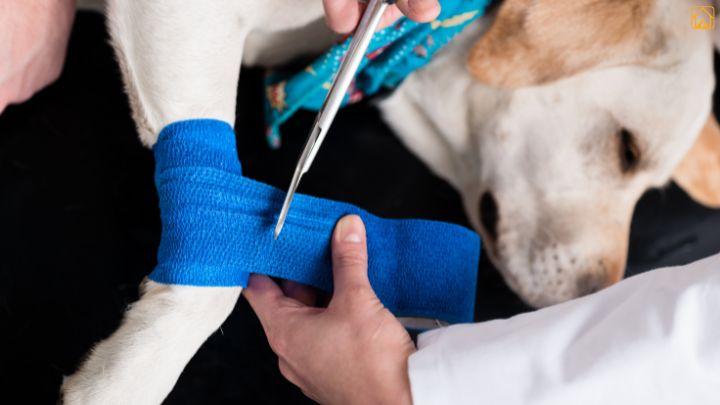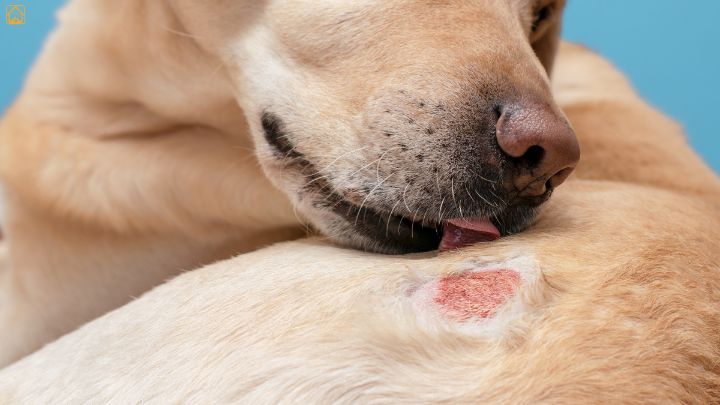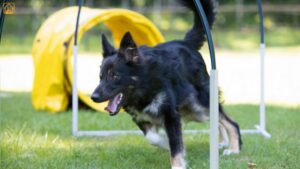What is Acral Lick Dermatitis in Dogs (Lick Granuloma)?
Acral lick dermatitis, also known as canine lick granuloma, is a skin condition caused by a dog obsessively licking one area, usually the lower leg or paw. This constant licking leads to swelling, redness, and eventually a thick, hairless, and sometimes open sore that’s tough to heal without proper care.
The term “acral” refers to the limbs and ends of the body, which is why these lesions usually show up on the front legs, around the wrist (carpal joint), or back legs near the ankle (hock). It often begins with a mild itch or irritation but can quickly spiral into a serious wound.
- Are most common on the front legs, but may appear anywhere the dog can reach
- Form due to repeated licking that creates a stubborn, open wound
- Often result from both medical issues (like allergies or pain) and emotional stress (like boredom or anxiety)
Common Causes and Risk Factors
Physical Triggers
Why do dogs start licking in the first place? There’s rarely a single answer. Often, acral lick dermatitis in dogs begins with a minor physical issue, like an insect bite, skin infection, allergy, or joint pain. Once the cycle of licking starts, it’s tough to stop, especially if the root problem isn’t addressed.
- Allergies: Food allergies or environmental allergens can cause itchy skin, making dogs target their paws or legs
- Infections: Bacterial, fungal, or yeast infections may irritate the skin
- Joint or bone pain: Arthritis or past injuries can make the area uncomfortable, prompting licking
- Nerve damage: Trauma or surgery may create odd sensations that lead to compulsive licking
Psychological and Behavioural Factors
Here’s the weird part, sometimes, even after the skin heals, dogs keep licking out of habit. Behavioural components like anxiety, boredom, or stress play a huge role. Ever notice your dog licking more when you’re gone or when routines change? That’s not just a coincidence.
- Boredom: Lack of exercise or stimulation leads to self-soothing behaviours
- Separation anxiety: Dogs alone for long periods often develop repetitive behaviours
- Obsessive-compulsive tendencies: Some breeds are more prone to compulsive licking
Risk Factors
- Medium-to-large breeds are at higher risk
- Older dogs more commonly affected
- Dogs with a history of allergies, arthritis, or previous skin issues
In my experience, it’s usually a mix of triggers, which is why treating acral lick dermatitis in dogs takes a whole-dog approach.
Symptoms and How to Recognize Lick Granuloma
Catching acral lick dermatitis early can save your dog a lot of discomfort. It usually begins with subtle signs like a little extra licking, a small patch of missing hair. But things can escalate fast. I remember thinking my dog Bunny licking his paws normally until I found an angry red sore forming on his wrist within days. Dogs often lick more when they’re bored, anxious, or left alone, so it’s easy to miss until the damage is done. Paying attention to these small changes early on can prevent a minor irritation from turning into a long-term problem.
- Well-defined, raised, oval or round patch on the skin, usually red, hairless, and moist
- Thickened, leathery, or ulcerated skin in chronic cases
- Location: Most common on the front legs (wrist/carpal area), sometimes rear legs or paws
- Persistent licking, chewing, or biting at the same spot
- Secondary infection: Oozing, pus, or foul odor if bacteria invade
- Behaviour changes: Dog may seem anxious, withdrawn, or focused on the lesion
Quick tip: If you spot a lick sore that won’t heal, or if the area looks thicker, darker, or wet, it’s time to get your vet involved. Chronic lesions can deepen and get infected fast.
Dog Breeds Prone to Acral Lick Dermatitis
Not all dogs are equally at risk for acral lick dermatitis in dogs. Some breeds seem almost magnetically drawn to this frustrating condition. While any dog can develop a lick granuloma, medium and large breeds with sensitive skin are most often affected.
- Doberman Pinschers
- Great Danes
- Labrador Retrievers
- Golden Retrievers
- German Shepherds
- Weimaraners
- Irish Setters
- Boxers
Males are reported to be affected a bit more than females. Older dogs (over 5 years) are also at higher risk. But honestly, I’ve seen even smaller breeds get lick granulomas if the right triggers like anxiety or allergies are there. So don’t ignore the signs, no matter your dog’s size.
How Veterinarians Diagnose Acral Lick Dermatitis
Initial Assessment
When you show up at the vet worried about acral lick dermatitis in dogs, the first thing your vet does is check the location and appearance of the lesion. A bald, thick, red spot on the lower limb is a big clue. But the detective work doesn’t stop there.
- Detailed history: How long has the licking been going on? Any recent changes, injuries, allergies, or new foods?
- Complete physical exam: Looking for pain, arthritis, lumps, or other skin issues
Diagnostic Tests
- Skin scrapings and cultures: To rule out mites, mange, bacterial, or fungal infections
- Skin biopsy: Especially if the lesion doesn’t heal or looks unusual, rules out tumors or deep infections
- Radiographs (X-rays): To check for arthritis, bone pain, or hidden trauma
- Allergy testing: Blood or intradermal tests if allergies are suspected
Sometimes, despite all these tests, the root cause stays hidden. In those cases, veterinarians may bring in a veterinary behaviourist to help untangle the psychological triggers. Honestly, sometimes the medical part is the easy bit, it’s the mental side that’s a puzzle.
Medical Treatments: Medications, Laser, and Surgery

Addressing the Underlying Cause
Treating acral lick dermatitis in dogs often means playing detective. The best results come from tackling both the physical and psychological pieces. Here’s what your vet may recommend:
- Antibiotics: To fight off secondary skin infections (commonly prescribed: cephalexin, Convenia, Simplicef)
- Anti-inflammatory medications: Corticosteroids (oral or topical) to reduce swelling and itching
- Pain relief: Medications like carprofen or gabapentin if arthritis or nerve pain is a factor
- Anti-anxiety or behavioural meds: Fluoxetine, clomipramine, or alprazolam if stress or compulsive licking is suspected
- Antifungals: Ketoconazole if a fungal infection is found
Topical Treatments and Barrier Methods
- Antiseptic wipes and sprays: Chlorhexidine, Douxo S3 products, or medicated shampoos
- Protective collars: Elizabethan (cone) collars, inflatable collars, or specially designed lick granuloma sleeves/wraps to prevent further trauma
- Bitter-tasting sprays: To discourage licking (though some dogs are stubborn!)
Advanced Therapies
- Lick granuloma laser treatment: CO2 or cold laser therapy can help reduce inflammation and speed healing in select cases
- Acupuncture: Sometimes recommended for pain or behavioural support
- Surgery: For chronic, non-healing lesions, surgical removal or debridement may be needed, though results can vary
One thing I’ve learned: there’s rarely a single magic bullet. Treatment is often a marathon, not a sprint. Combining medical treatment with behaviour modification and careful home care gives your dog the best shot at healing.
Home Care and Natural Remedies for Lick Granuloma
Home Management Strategies
While you can’t cure acral lick dermatitis in dogs overnight with home remedies alone, there’s a lot you can do to support healing and prevent setbacks.
- Keep the area clean and dry: Gently wash with a mild, vet-approved antiseptic
- Protect the lesion: Use a lick granuloma wrap or sleeve, or an e-collar, to block access
- Discourage boredom: Provide puzzle toys, chew treats, or safe bones to divert attention
- Monitor for infection: Watch for redness, swelling, pus, or foul odor, see your vet if these appear
Natural Remedies for Lick Granuloma in Dogs
- Coconut oil or aloe vera: May soothe mild irritation (always check with your vet first)
- Calendula ointment: Some pet parents find this herbal salve calming for minor skin wounds
- Omega-3 supplements: Fish oil can help support skin health from within
- Chamomile compresses: Cooled tea bags may provide mild relief, but only for non-open wounds
Important: Never apply essential oils, harsh chemicals, or human medications without veterinary guidance. What’s safe for us can be toxic for dogs.
When to See Your Vet
If home care isn’t improving the sore in a week, or if you see signs of infection, pain, or spreading lesions, don’t wait, get professional help. Chronic lick granulomas can cause deep infections or even bone involvement if left unchecked.
Prevention Tips: Reducing the Risk of Lick Granuloma Recurrence
Once you’ve dealt with acral lick dermatitis in dogs, you’ll do anything to avoid a repeat. The key is to stay proactive and consistent. Here’s how I keep Bunny’s old “lick spot” from making a comeback:
- Schedule regular vet checkups to catch allergies, arthritis, or skin issues early
- Keep your dog’s mind and body busy, daily exercise and mental stimulation are non-negotiable
- Watch for signs of boredom or anxiety, especially during routine changes
- Address small wounds or irritations before they become big problems
- Use protective wraps, sleeves, or e-collars during high-risk times like after surgery or stressful events.
- Feed a balanced diet with skin-supporting nutrients
Remember, prevention is a team effort. Stay connected with your vet, and don’t hesitate to ask for help if you spot early signs.
Behavioural Modification and Environmental Management
Here’s where things get personal, and honestly, sometimes a little tricky. Acral lick dermatitis in dogs often has a big behavioural piece. If you don’t address the WHY behind the licking, the problem keeps coming back.
Behavioural Modification Tips
- Increase exercise: More walks, playtime, and off-leash runs help burn excess energy
- Enrichment activities: Puzzle feeders, scent games, and interactive toys keep minds busy
- Positive attention: Reward calm behaviours; don’t scold for licking (it can worsen anxiety)
- Shorter, more frequent training: Teach new tricks, basic obedience, or agility to build confidence
Environmental Changes
- Reduce time alone, if possible
- Provide soft bedding and comfortable resting spots
- Minimize exposure to known stressors (loud noises, unfamiliar visitors, etc.)
- Try calming aids: pheromone diffusers, gentle music, or anxiety wraps
If the behaviour feels compulsive or out of control, ask your vet about referral to a veterinary behaviourist for specialized support.
Conclusion
For more help with dog skin problems, check out our other articles on dog health issues and skin infections.
References:



